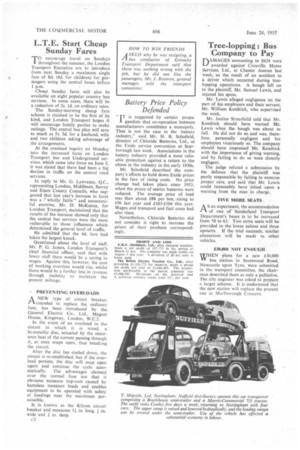L.T.E. Start Cheap Sunday Fares
Page 42

If you've noticed an error in this article please click here to report it so we can fix it.
To encourage travel on Sundays throughout the summer, the London Transport Executive are to introduce from next Sunday a maximum single fare of 8d. (4d. for children) for passengers using the central buses before 1 p.m. Cheap Sunday fares will also be available on eight popular country bus services. In some cases, there will be a reduction of 2s. Id. on ordinary rates. The Sunday-morning cheap fare scheme is claimed to be the first of its kind, and London Transport hopes it will encourage family parties to make outings. The central bus plan will save as much as 5s. 3d. for a husband, wife and two children taking advantage of the arrangements. At the resumed inquiry on Monday into the increased fares on London Transport bus and Underground services, which came into force on June 5, it was stated that there had been a big decline in traffic on the central road services. In reply to Mr. G. Lawrencc, Q.C., representing London, Middlesex, Surrey and Essex County Councils, who suggested that last year's increase in fares was a ," wholly futile" and unsuccessful exercise, Mr. D. McKenna, for London Transport, maintained that the results of the increase showed only that the central bus services were the most vulnerable to those influences which determined the general level of traffic. He admitted that the 4d. fare had taken the largest knock. Questioned about the level of staff, Mr. P. G. James, London Transport's chief financial officer, said that with fewer staff there would be a saving in wages. Against this, however, the cost of working overtime would risc, whilst there would be a further loss in reveaue through inability to maintain the present mileage.
PREVENTING OVERLOADS
A NEW type of circuit breaker, I-1 intended to replace the ordinary fuse, has been introduced by the General Electric Co., Ltd., Magnet 1-fouse, Kingsway, London, W.C.2. In the event of an overload in the circuit in which it is wired, a bi-metallic disc, actuated by the resistance heat of the current passing through it, at once snaps open, thus breaking the circuit. After the disc has cooled down, the circuit is re-established, but if the overload persists, the disc will snap open again and continue the cycle automatically. The advantages claimed over the normal fuse are that it obviates nuisance trip-outs caused by harmless transient loads and enables equipment to be operated with safety at loadings near the maximum permissible. It is known as the Klizon circuit breaker and measures LI in. long, in.
wide and in. deep. (-2








































































































